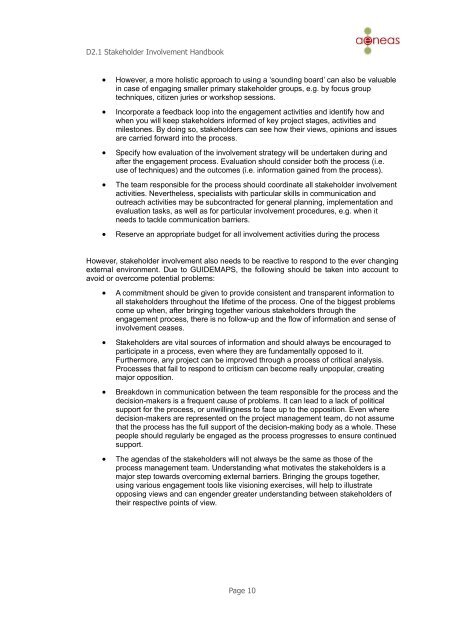D2.1 Stakeholder Involvement Handbook - AENEAS
D2.1 Stakeholder Involvement Handbook - AENEAS
D2.1 Stakeholder Involvement Handbook - AENEAS
Create successful ePaper yourself
Turn your PDF publications into a flip-book with our unique Google optimized e-Paper software.
<strong>D2.1</strong> <strong>Stakeholder</strong> <strong>Involvement</strong> <strong>Handbook</strong><br />
• However, a more holistic approach to using a ‘sounding board’ can also be valuable<br />
in case of engaging smaller primary stakeholder groups, e.g. by focus group<br />
techniques, citizen juries or workshop sessions.<br />
• Incorporate a feedback loop into the engagement activities and identify how and<br />
when you will keep stakeholders informed of key project stages, activities and<br />
milestones. By doing so, stakeholders can see how their views, opinions and issues<br />
are carried forward into the process.<br />
• Specify how evaluation of the involvement strategy will be undertaken during and<br />
after the engagement process. Evaluation should consider both the process (i.e.<br />
use of techniques) and the outcomes (i.e. information gained from the process).<br />
• The team responsible for the process should coordinate all stakeholder involvement<br />
activities. Nevertheless, specialists with particular skills in communication and<br />
outreach activities may be subcontracted for general planning, implementation and<br />
evaluation tasks, as well as for particular involvement procedures, e.g. when it<br />
needs to tackle communication barriers.<br />
• Reserve an appropriate budget for all involvement activities during the process<br />
However, stakeholder involvement also needs to be reactive to respond to the ever changing<br />
external environment. Due to GUIDEMAPS, the following should be taken into account to<br />
avoid or overcome potential problems:<br />
• A commitment should be given to provide consistent and transparent information to<br />
all stakeholders throughout the lifetime of the process. One of the biggest problems<br />
come up when, after bringing together various stakeholders through the<br />
engagement process, there is no follow-up and the flow of information and sense of<br />
involvement ceases.<br />
• <strong>Stakeholder</strong>s are vital sources of information and should always be encouraged to<br />
participate in a process, even where they are fundamentally opposed to it.<br />
Furthermore, any project can be improved through a process of critical analysis.<br />
Processes that fail to respond to criticism can become really unpopular, creating<br />
major opposition.<br />
• Breakdown in communication between the team responsible for the process and the<br />
decision-makers is a frequent cause of problems. It can lead to a lack of political<br />
support for the process, or unwillingness to face up to the opposition. Even where<br />
decision-makers are represented on the project management team, do not assume<br />
that the process has the full support of the decision-making body as a whole. These<br />
people should regularly be engaged as the process progresses to ensure continued<br />
support.<br />
• The agendas of the stakeholders will not always be the same as those of the<br />
process management team. Understanding what motivates the stakeholders is a<br />
major step towards overcoming external barriers. Bringing the groups together,<br />
using various engagement tools like visioning exercises, will help to illustrate<br />
opposing views and can engender greater understanding between stakeholders of<br />
their respective points of view.<br />
Page 10




